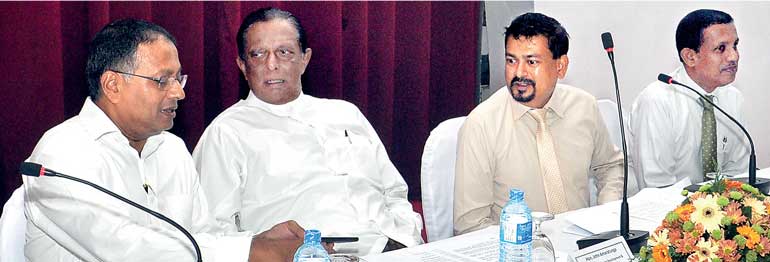Thursday Apr 25, 2024
Thursday Apr 25, 2024
Thursday, 24 August 2017 00:18 - - {{hitsCtrl.values.hits}}
 By Charumini de Silva
By Charumini de Silva
In the latest attempt to regulate informal tourist operators, Tourism Development Minister John Amaratunga called on authorities to set up countrywide committees to submit the full details of homestay operators in order to build a database by December.
He stressed the importance of standardising homestay operators countrywide, noting that the tourism sector has been recognised as a thrust industry for economic development.
“No country in the world wants to wipe out the homestay segment from the tourism industry because it is one of the important sectors which trickles down the benefits to the grassroots levels of the communities. The need to regulate the informal segment was not to eliminate it but to uplift and ensure that travellers will enjoy a safe, comfortable and clean home away from home and unforgettable experience,” he said at the inauguration of a Home Stay Awareness and Training Program conducted by SLTDA in Colombo yesterday.
Tourism officials last year launched an ambitious set of regulations to give every hotel in Sri Lanka a star rating in a sweeping effort to bring service levels up to international standards and implement a policy that has been in the pipeline for over a decade. However, it was pointed out yesterday that only 773 homestay operators have registered with the LTDA with a 2,714-room capacity, while a lot more units are to be brought into the system.

While five-star hotels in the country enjoy most of the earnings they receive from the sector, the Minister admitted that the informal sector contributes significantly to uplifting the livelihoods of the rural economy of the island.
Acknowledging the power of social media, he urged homestay operator to maintain a database of transport and other suppliers to eradicate any awful experiences for foreigners as they tarnished an image which has been built over many years.
Amaratunga said homestays were not a new concept and were well-practiced in countries like Thailand, Malaysia, Vietnam and Brazil. However, he pointed out that in those countries they manage this segment systematically and up to a high standard.
“This is what is lacking in our country and by setting up the communities we want to systematically uplift the standards of this segment,” he added.
Outlining the tourist industry highlights from January to July this year, SLTDA Director General Malraj Kiriella said over 1.2 million arrivals have been recorded with an average growth of 3.8% y-o-y, where the duration of a stay is 10.2 nights.
Based on an airport survey conducted last year, 38.4% travellers have made their own arrangements, while 37.7% have organised through internet, 21% through a tour operator and 2% through a travel agent in Sri Lanka. Most of these tourists have engaged in activities such as sightseeing, sea bathing, visits to historic sites, shopping, wildlife and round tours at tourist attractions including Kandy, South and West coastal beaches, Colombo city for shopping, Sigiriya, Dambulla, the hill country and wildlife parks.
In terms of the types of accommodation facilities used, the majority of travellers who visited Sri Lanka last year preferred staying in the formal sector of hotels. According to the survey, 57% of tourists stayed in hotels while 30% in guest houses, 7% chose homestays, 3% with friends and relatives, 2% in apartments and 1% used other forms of accommodation.
Kiriella identified education, entertainment, food, accommodation and hospitality as vital components of homestay units.
Commenting on the benefits of homestays to the local community, he pointed out that they created job opportunities, provided supplementary income, improved the quality of life, increased economic diversification, enhanced environmental integrity, preserved cultural and natural heritage and uplifted training and capabilities in business development and tourism.
In addition, value for money, meeting local people, the capability to explore beyond the tourist trail, learn local cultures and customs, experience a real home away from home and unforgettable memories were identified as the benefits for foreign travellers.
The affordable homestay accommodation benefitting expectations and tastes are sub-categorised into three segments including homestay units, bungalows and rented houses or apartments. As per the SLTDA, the most popular areas for homestays in Sri Lanka are Anuradhapura, Batticaloa, Colombo, Galle, Hambantota, Jaffna, Kalutara, Kandy, Matara, Nuwara Eliya, Polonnaruwa, Puttalam, Ratnapura, Trincomalee, Gampaha, Matale, Kurunegala and Ampara.
Of the three categories, Kandy is at the top in terms of homestay units with 24% followed by Colombo 16%, Badulla 15% and Kalutara 6%, while in the bungalows category Kandy once again leads with 17%, Galle 16%, Colombo 13% and Gampaha7%. In terms of rented houses and apartments, Colombo dominates with 56% followed by Kandy 15%, Galle 8% and Gampaha 5%.
The full-day program saw around 100 homestay operators from across the island.
Pix by Ruwan Walpola